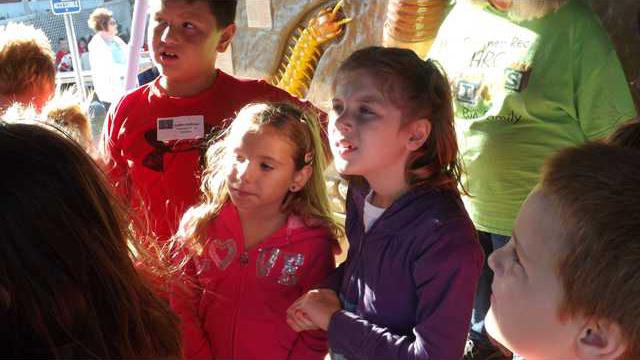Four hundred second graders from throughout Barton County, the largest amount ever, flocked to the Kansas Wetlands Education Center on Wednesday to learn about the wetlands in their own backyard on a warm sunny fall day.
Migrating between seven learning stations, the students spent half a day at KWEC as a part of the 4th annual Wetlands Education Day sponsored by the Friends of Cheyenne Bottoms.
“The kids are excited, the volunteers are excited. We’re looking forward to a good year,” said Roger Butler, president of the board of directors of the FCB.
This day, “gives (kids) a chance to learn about wetlands and wildlife,” said Butler. He added they learn the importance of conservation, wildlife and the KWEC.
A new station this year was a display by the Kansas Department of Wildlife Parks and Tourism from the Pratt fish hatchery and museum. It is the only hatchery in the state that raises channel catfish, beginning in 1903.
The children saw the young catfish or fry in a tank, as well as sunfish, a cross between blue gill and sunfish. They also learned that the hatchery raises large mouth bass and walleye.
Chris Shrack, KDWP & T, asked the kids if they liked to fish, which about half did and whether they liked to eat fish, which about half did. The rest thought fish were yucky.
In the wild, males raise the channel catfish babies, Schrack said. The babies or fry are released into the wild when they get to be about one-and-a-half inches long.
The hatchery, which is more efficient than mother nature according to Schrack, raises tens of thousands of fish each year.
Another station, the scavenger course was designed to educate the children about the obstacles birds face to stay alive, and that they even fly at night during migration. When students ran the course, they had to avoid electrical lines, tall buildings, shrinking habitats, toxic chemicals and cats.
The second graders also learned about night sounds, participated in a scavenger hunt, learned about the plant life, visited the soil trailer and went on a nature hike.
Many volunteers and sponsors work together to make the day happen. “I appreciate the sponsors that allow us to do this,” said Butler. “We have a great group of volunteers. Everybody worked hard.”
Second graders flock to KWEC for education day





